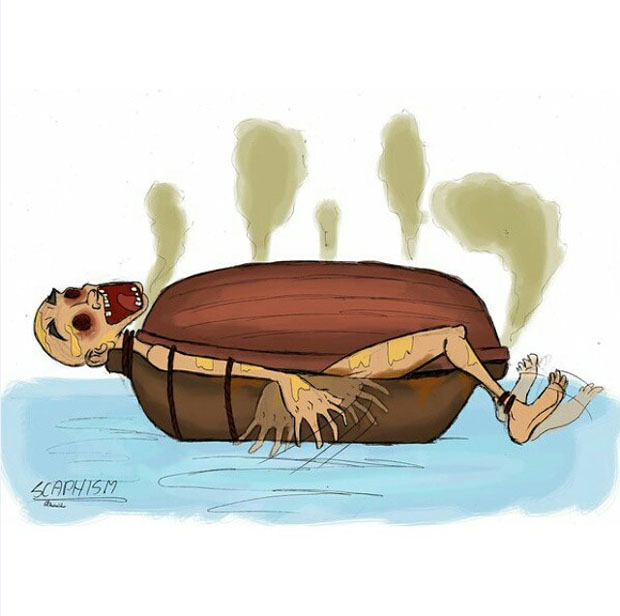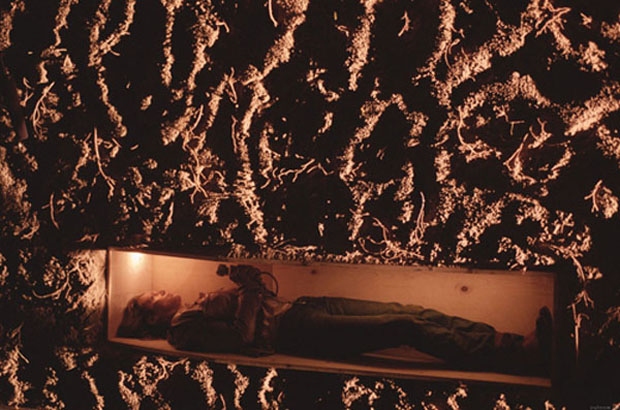24 Unsettling Methods Of Execution
Don't read this if you have a heart condition.
Published 9 years ago
1
STONING Or lapidation, is a form of capital punishment by torture whereby a group throws stones at a person until he or she dies. Methods vary, though the victim is often bound and/or partially buried in the ground first. As many people throw the stones, no individual among the group can be identified as the one who has killed the subject. Still performed in some parts of the world today, there are also historical reports of stoning as far back as Ancient Greece.
2
CRUSHING (PRESSING) Was made famous in America by the case of Giles Corey, who was pressed to death during the Salem Witch Trials in Salem, Massachusetts. He was placed between two large boards as increasing weight was placed on top, in an attempt to get him to confess to being a witch. Giles refused, and it’s said his last words were “more weight.”
3
BOILING In execution by boiling, the condemned is stripped naked and either placed in a vat of boiling liquid, or in a vat of cold liquid which was then heated to boiling. The liquid could be oil, acid, tar, water, or molten lead. During the reign of King Henry VIII it was a punishment especially reserved for poisoners.
4
THE BLOOD EAGLE First the intended victim would be restrained, face down; next, the shape of an eagle with outstretched wings would be cut into his back. After that, his ribs would be hacked from his spine with an ax, one by one, and the bones and skin on both sides pulled outward to create a pair of “wings” from the man’s back. The victim, it is said, would still be alive at this point to experience the agony of what Turner terms “saline stimulant”—having salt rubbed, quite literally, into his vast wound. After that, his exposed lungs would be pulled out of his body and spread over his “wings,” offering witnesses the sight of a final bird-like “fluttering” as he died.
5
THE BRAZEN BULL Was a torture and execution device designed in ancient Greece. It was a bronze oven in the shape of a bull, just large enough to fit an adult. The offender would be placed in the belly of the beast, and sealed inside. Fire would be placed directly below the bull until the screams and smoke of the roasting victim would come out of the bulls mouth. The interior acoustics converted the victims' screams to sound "bull-like" as they emerged. They say that the person that created this was the first person to by killed in it.
6
THE BREAKING WHEEL (CATHERINE WHEEL) Was a torture and execution device used for capital punishment from Antiquity into early modern times for public execution by breaking the victim's bones/bludgeoning him to death. The wheel was typically a large wooden wagon wheel with many radial spokes. The condemned were lashed to the wheel and their limbs were beaten with a club or iron cudgel, with the gaps in the wheel allowing the limbs to give way and break. Alternatively, the condemned were spreadeagled and broken on a saltire, a cross consisting of two wooden beams nailed in an "X" shape, after which the victim's mangled body might be displayed on the wheel. The survival time after being "broken" could be extensive. Accounts exist of a 14th-century murderer who lived for three days after undergoing the punishment. In 1348, during the time of the Black Death, a Jew named Bona Dies underwent the punishment. The authorities stated he lived for four days and nights afterwards.
7
BURNING AT THE STAKE Is the best known type of execution by fire, practiced in many parts of the world throughout history. The condemned is bound to a large wooden stake, surrounded and above a collection of flammable materials (most commonly wood). If the fire was large (for instance, when a number of people were executed at the same time), death often came from carbon monoxide poisoning before flames actually caused harm to the body. However, if the fire was small enough, the victim would burn for some time until death from hypovolemia (the loss of blood and/or fluids, since extensive burns often require large amounts of intravenous fluid, because the subsequent inflammatory response causes significant capillary fluid leakage and edema), heatstroke and/or simply the thermal decomposition of vital body parts.
8
KEELHAULING Was a form of punishment historically meted out to sailors at sea. The sailor was tied to a line that looped beneath the vessel, thrown overboard on one side of the ship, and dragged under the ship's keel, either from one side of the ship to the other, or the length of the ship (from bow to stern). As the hull was usually covered in barnacles and other marine growth, if the offender was pulled quickly, keelhauling would typically result in serious cuts, loss of limbs and even decapitation. If the victim was dragged slowly, his weight might lower him sufficiently to miss the barnacles, but this method would frequently result in his drowning. Keelhauling was legally permitted as a punishment in the Dutch Navy by a Dutch ordinance of 1560, and the practice was not formally abolished until 1853. Keelhauling has become strongly associated with pirate lore. The earliest known mention of keelhauling is from the Greeks in the Rhodian Maritime Code (Lex Rhodia), of circa 800 BC, which outlines punishment for piracy. It is also pictured on a Greek vase from the same era.
9
IMMUREMENT Is the permantent confinement of a person by walling off any exits. This was usually intended as a form of imprisonment for life, rather than of capital punishment (example: the countess Elisabeth Bathory, who lived for four more years after having been immured). However, in one form or another, death is the eventual result.
10
THE LEAD SPRINKLER Was a device where the torturer would pour molten metals in one end, and then sprinkle the contents on the victim with the other. For executions, the device would be used to pour molten silver into the eyes of the victim. This caused tremendous pain, blindness, and eventual death.
11
GIBBETING Was the most preferred torture technique in the Middle Ages, and a familiar public execution method for, among other things, piracy. This method involved placing the victim outdoors, inside of a metal cage roughly the size of the human body. The torturers also forced overweight victims into smaller cages to heighten their discomfort as they hung from a tree or gallows. Generally, they would be left there until the crows came to feed on their remains.
12
DEATH BY SAWING Allegedly once practiced in parts of Europe, Spain, and Asia, involved the victim being inverted and then sawn in half starting at the groin. Due to being upside down the brain would receive enough blood to keep the person conscious until the large vessels of the abdomen were severed.
13
FLAYING ALIVE The widespread practice of removing the skin from a still-living body. Generally, an attempt is made to keep the removed portion of skin intact. Records show that the actual flaying process might begin at various places on the body, such as at the crus (lower leg), the thighs, or the behind. The typical causes of death due to flaying are shock, critical loss of blood or other body fluids, hypothermia, or infections. The actual death is estimated to occur from a few hours up to a few days after the process begins.
14
SCAPHISM Also known as the boats, was an ancient Persian method of execution designed to inflict torturous death that was described by the Persians' archenemies, the Greeks. The intended victim was stripped naked and then firmly fastened within the interior space of two narrow rowing boats (or hollowed-out tree trunks) joined together one on top of the other with the head, hands and feet protruding. The condemned was forced to ingest milk and honey to the point of developing severe diarrhea, and more honey would be poured on him to attract insects, with special attention devoted to the eyes, ears, mouth, face, genitals, and anus. He would then be left to float on a stagnant pond or be exposed to the sun. The defenseless individual's feces accumulated within the container, attracting more insects which would eat and breed within the victim's exposed flesh, which—pursuant to interruption of the blood supply by burrowing insects—became increasingly gangrenous. Death, when it eventually occurred, was probably due to a combination of dehydration, starvation, and septic shock. Delirium would typically set in after a few days.
15
THE RACK Was designed to dislocate every joint of the victim’s body, it was believed to be the most painful form of medieval torture. This torture device was made out of a wooden frame with two ropes fixed to the bottom and the other two tied into the handle on top. Once the victim was bound and placed on top of the rack, the torturer would proceed to turn the handle. Eventually, the victim would be stretched until his limbs were dislocated. The torturers would often continue to turn the wheel until the limbs were completely torn off the victim’s body, resulting in death.
17
CRUCIFIXION Was a particularly brutal method of execution practiced primarily by the Romans, it was intended to be as slow and painful as possible. Usually after a prolonged period of beating or torture, the victims were either nailed or tied to a wooden cross where they would hang, sometimes for several weeks. Death, when it did come, usually came by suffocation as the victim could no longer hold themselves up to breathe.
18
BAMBOO TORTURE & EXECUTION Is where a bamboo shoot is slowly grown through the body of a victim, reportedly used in East and South Asia. The cast of the TV program MythBusters investigated bamboo torture in a 2008 episode and found that a bamboo shoot can penetrate through several inches of ballistic gelatin in three days. For research purposes, ballistic gelatin is considered comparable to human flesh, and the experiment thus supported the viability of this form of torture, not its historicity.
19
THE SPANISH TICKLER Was a terrible device used in most of Europe during the Middle Ages. It's a very simple instrument that was used to tear a victim's skin apart. Due to its shape, neither bones nor muscles were spared. The Spanish Tickler varied in shape and size. Some were long and had a pole attached to the rear so the torturer could tear the skin from a distance, while others were nothing but the claw itself. Depending on the instrument, the torture varied. This torture often resulted in death, but some victims were spared or convicted to a shorter torture session.
20
LING CHI Also known as the “death by slow cutting” or the “lingering death”. This form of execution was finally outlawed in China at the turn of the 20th century. It involved small pieces of the victims body being slowly and methodically removed while the executioner tried to keep him or her alive for as long as possible.
21
IMPALEMENT Forced the victim to sit on a sharp and thick pole. When the pole was then raised upright, the victim was left to slide down onto the pole with their own weight. It could take the victim several days to die using this method. This method was most favored by Vlad the Impaler in 15th century Romania.
23
HANGED, DRAWN, AND QUARTERED Used mainly in England, it is widely considered to be one of the most brutal forms of execution ever devised. In the first the victim was tied to a wooden frame and dragged to the location of their execution. They were then hanged until nearly dead. Immediately after being taken down their abdomen was opened and their entrails were removed. As the victim watched they were then burned before his or her eyes. He was then also emasculated and eventually beheaded. After all of this his body was divided into four parts and placed in various locations around England as a public crime deterrent. This punishment was only used on men for any convicted woman would generally be burnt at the stake as a matter of decency.
24
RAT TORTURE Involved strapping a metal cage or pot containing large rodents against the victim’s body (usually the lower abdomen). A heating element would be placed on the container, and the rodents’ natural instinct would lead them to flee the intense heat. In order to escape they would burrow through the victim’s body, with painful and slowly fatal results.



























